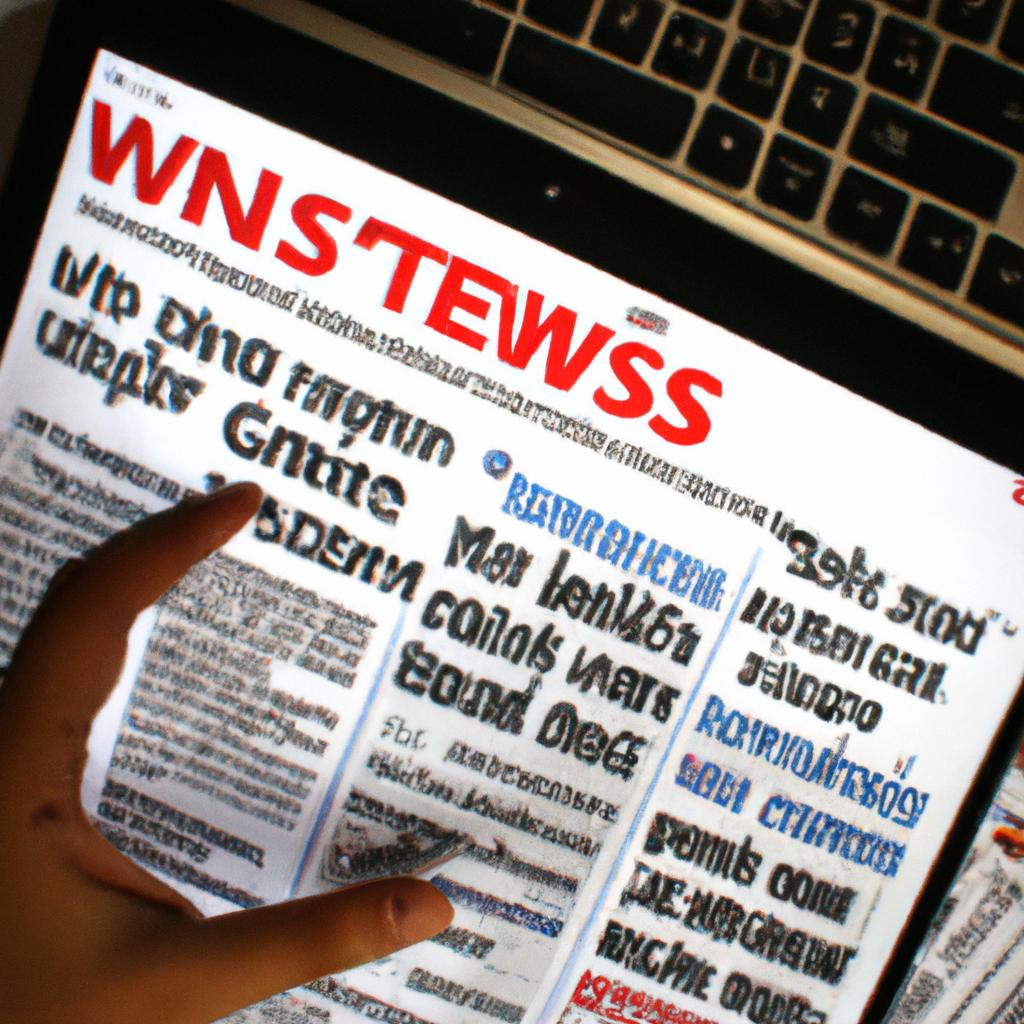Misinformation Unveiled: Fake News in the News Media Industry
In today’s digital age, where information is readily accessible and constantly shared through various media platforms, the spread of misinformation has become a pressing concern. The news media industry, once revered as a reliable source of factual reporting, is now plagued by instances of fake news that can have far-reaching consequences. For instance, consider the case of the 2016 United States presidential election, where false stories circulated on social media platforms influenced public opinion and potentially impacted voting outcomes. This article delves into the multifaceted issue of fake news within the news media industry, examining its causes, effects, and potential solutions.
The proliferation of technology has provided individuals with unprecedented access to information from an array of sources. While this increased accessibility brings about numerous benefits, it also opens doors for misinformation to infiltrate public discourse. In recent years, instances of fake news disseminated through online channels have grown exponentially. These fabricated or distorted stories often mimic real journalistic pieces but are intentionally designed to deceive readers and manipulate their perspectives. As a result, trust in traditional news outlets diminishes while reliance on alternative sources increases – perpetuating a cycle wherein misinformation thrives and authentic journalism struggles to regain its footing amidst an overcrow of information.
One of the key causes of fake news in the news media industry is the rise of social media platforms as primary sources of news consumption. These platforms, while providing a space for individuals to express their opinions and share information, also create an environment where misinformation can easily spread. The algorithms used by these platforms prioritize engagement and popularity, often leading to the amplification of false or sensationalized stories.
Additionally, the democratization of content creation through blogs, websites, and social media has lowered the barrier to entry for spreading information. This means that anyone with an internet connection can publish content without adhering to journalistic standards or fact-checking processes. As a result, misleading or false information can quickly gain traction and become widely shared before it can be debunked.
The effects of fake news on society are far-reaching. It erodes trust in established news outlets and undermines the credibility of reliable journalism. Misinformation can manipulate public opinion, shape political discourse, and even influence election outcomes. It also contributes to societal polarization as people consume news that aligns with their preexisting beliefs rather than seeking out diverse perspectives.
Addressing fake news requires a multi-faceted approach involving various stakeholders. News organizations must prioritize fact-checking and accuracy in their reporting while transparently correcting any errors made. Technology companies need to invest in developing algorithms that prioritize trustworthy sources over sensationalized or clickbait content. Media literacy education should be promoted at all levels to equip individuals with critical thinking skills needed to distinguish between credible and false information.
Furthermore, governments could play a role by implementing regulations that hold both individuals spreading fake news and technology companies accountable for its dissemination.
In conclusion, tackling the issue of fake news within the news media industry is crucial for preserving democratic values and informed decision-making. By understanding its causes, effects, and potential solutions outlined above, steps can be taken towards mitigating its impact on society as a whole.
The Rise of Misinformation
Misinformation has become a prevalent issue in the news media industry, posing serious challenges to the dissemination of accurate information and public trust. To illustrate this phenomenon, let us consider a hypothetical scenario where a prominent news outlet publishes a sensationalized story about an alleged breakthrough in cancer research. This article gains widespread attention and is shared extensively on social media platforms, reaching millions of users within hours. However, upon closer examination, it is revealed that the claims made in the article are unfounded and unsupported by scientific evidence.
The rise of misinformation can be attributed to several factors. Firstly, the ease of sharing information on digital platforms has accelerated its spread exponentially. With just a few clicks, anyone can share content with thousands or even millions of people instantaneously. This rapid dissemination allows false information to gain traction before corrections or fact-checking mechanisms can take effect.
Furthermore, the proliferation of echo chambers and filter bubbles exacerbates the problem. Social media algorithms often personalize individuals’ news feeds based on their previous interactions and preferences. As a result, people are more likely to be exposed only to information that aligns with their existing beliefs and biases. This confirmation bias perpetuates the circulation of misleading or inaccurate stories among like-minded communities.
- People may experience fear or panic when confronted with alarming but false information.
- Trust in traditional news sources may decline as individuals question their credibility.
- Communities can become polarized due to conflicting narratives propagated by different groups.
- Individuals might make ill-informed decisions based on unreliable information.
Additionally, visual aids such as tables help evoke an emotional response from readers:
| Consequences of Misinformation |
|---|
| Increased anxiety |
| Impaired decision-making |
| Public skepticism |
| Social unrest |
In light of these challenges, it is crucial to understand the impact misinformation has on public perception.
Transitioning smoothly into the subsequent section about “The Impact on Public Perception,” it becomes evident that addressing the issue of misinformation requires a comprehensive understanding of its effect on society as a whole.
The Impact on Public Perception
The proliferation of misinformation in the news media industry has had a profound impact on public perception. One case study that exemplifies this is the spread of false information during the 2016 U.S. presidential election. Various news outlets, both traditional and digital, disseminated misleading stories and fabricated narratives aimed at influencing voters’ opinions.
This influx of misinformation not only erodes trust in the news media but also distorts public perception and decision-making processes. Here are some key impacts:
- Cognitive biases: Misinformation can exploit cognitive biases, such as confirmation bias or availability heuristic, leading individuals to accept falsehoods that align with their pre-existing beliefs or seem easily accessible.
- Emotional manipulation: False stories often evoke strong emotional responses from readers/viewers, triggering anger, fear, or outrage. These emotions can cloud judgment and make it easier for misinformation to be accepted without critical evaluation.
- Polarization: Misinformation contributes to societal polarization by reinforcing existing divisions between different groups. It creates an ‘us versus them’ mentality, fostering hostility and hindering constructive dialogue.
- Undermining democracy: By spreading falsehoods about political candidates or issues, misinformation undermines the democratic process itself. When citizens are misinformed, they may vote based on erroneous facts rather than making informed choices.
To illustrate these impacts further, consider the following table showcasing hypothetical examples of how misinformation affects public perception:
| Impact | Example |
|---|---|
| Cognitive biases | Voters believing false claims about candidate X |
| Emotional manipulation | Outrage over fabricated scandal involving politician Y |
| Polarization | Divisions deepening due to conflicting narratives surrounding issue Z |
| Undermining democracy | Dissemination of fake news affecting voter turnout |
In light of these significant consequences, addressing the issue of misinformation becomes crucial for maintaining a well-informed citizenry and healthy democratic discourse. The next section will explore the relationship between misinformation and political influence, shedding light on the broader implications of this pervasive problem. By understanding how misinformation can shape public opinion and impact political landscapes, we can begin to develop strategies for combating its detrimental effects.
Misinformation and Political Influence
From the impact of fake news on public perception, we now turn our attention to the concerning relationship between misinformation and political influence. To exemplify this connection, consider a hypothetical scenario where a false story circulates claiming that a prominent politician was involved in a scandal. Despite being entirely fabricated, this story gains traction on social media platforms and starts influencing public opinion about the politician negatively.
The spread of misinformation undoubtedly has far-reaching consequences in the political arena. Here are some key aspects worth examining:
-
Manipulation of Elections:
- False narratives can sway voters’ opinions, potentially leading to electoral outcomes influenced by inaccurate information.
- Dissemination of misleading content during election campaigns undermines democratic processes and compromises informed decision-making.
-
Polarization and Divisiveness:
- Misinformation often targets sensitive issues or exploits existing divisions within society.
- By amplifying extremist views or promoting controversial ideologies, fake news fuels polarization among citizens.
-
Erosion of Trust in Institutions:
- The consistent presence of misinformation erodes trust in traditional news sources as well as government institutions.
- This erosion weakens democratic institutions by undermining their credibility and ability to inform citizens effectively.
-
Foreign Interference:
- State-sponsored entities may utilize fake news tactics to meddle in other countries’ internal affairs.
- Spreading disinformation aims to sow discord, destabilize governments, and manipulate international relations.
Examining these repercussions reveals the gravity of the issue at hand. As misinformation infiltrates politics, it distorts public discourse, damages societal cohesion, and jeopardizes democratic values.
Transitioning from the discussion on political influence leads us naturally into an examination of social media’s role in spreading misinformation. Understanding how these platforms facilitate the dissemination of fake news is crucial for devising effective strategies to combat its harmful effects on society’s collective knowledge and well-being.
Social Media’s Role in Spreading Misinformation
Section 2: Misinformation and Political Influence
In recent years, the prevalence of misinformation in the news media industry has raised concerns about its impact on society. This section will delve into the relationship between misinformation and political influence, highlighting how false or misleading information can shape public opinion and potentially undermine democratic processes.
To illustrate this point, consider a hypothetical scenario where a prominent politician spreads false information about their opponent during an election campaign. Through carefully crafted narratives and targeted messaging, they manipulate public perception to gain an advantage. In such cases, misinformation becomes a powerful tool for influencing voter behavior, as individuals may base their decisions on inaccurate or distorted facts.
The following bullet points highlight some key aspects of misinformation’s role in political influence:
- Dissemination through trusted sources: Misinformation often spreads through reputable news outlets due to negligence or deliberate manipulation by influential actors.
- Amplification via social media: Platforms like Facebook and Twitter have become breeding grounds for the rapid dissemination of falsehoods, reaching wide audiences within seconds.
- Confirmation bias reinforcement: Individuals tend to seek out information that aligns with their existing beliefs, making them more susceptible to accepting and sharing misinformation that supports their worldview.
- Erosion of trust in institutions: Frequent exposure to fake news can erode public trust in traditional news media outlets and other authoritative sources.
| Misinformation Impact Matrix | |
|---|---|
| Misinformation Source | Potential Consequence |
| Politicians spreading false claims | Undermining democratic processes |
| Reputable news outlets disseminating unverified information | Damaging credibility and trustworthiness |
| Social media platforms amplifying falsehoods | Facilitating viral spread of misinformation |
| Confirmation bias reinforcement among readers | Reinforcing partisan divisions |
Understanding these dynamics is crucial for comprehending the far-reaching consequences of misinformation in politics. By exploring the mechanisms through which it infiltrates public discourse, we can begin to address the challenges it poses and work towards a more informed society.
With an understanding of how misinformation influences politics, the subsequent section will delve into social media’s role in spreading false information. By examining the unique characteristics of these platforms, we can gain insights into their contribution to the proliferation of misleading content. Fact-checking and its challenges will then be explored as potential solutions to combat misinformation effectively.
Fact-Checking and its Challenges
Transitioning from the role of social media in spreading misinformation, it is crucial to examine the challenges faced by fact-checkers in combating false information. To illustrate these challenges, let us consider a hypothetical case study where a misleading article circulates on multiple platforms claiming that a new scientific study has found a link between vaccines and autism. Despite being entirely baseless, this article gains traction quickly due to its alarming nature and taps into pre-existing fears within certain communities.
The process of debunking such misinformation involves several hurdles for fact-checkers:
- Speed: Misinformation often spreads rapidly across various online platforms, making it challenging for fact-checkers to keep up with the sheer volume of content that needs verification.
- Resource Constraints: Fact-checking requires extensive research, investigation, and expertise. However, many news organizations face limited resources and struggle to allocate sufficient time and personnel to thoroughly assess each piece of potentially misleading information.
- Emotional Appeal: False narratives tend to exploit emotions effectively as they evoke fear or outrage among audiences. This emotional response can overpower logical reasoning, increasing the susceptibility of individuals to believe and share inaccurate information.
- Echo Chambers: Social media algorithms may contribute to creating echo chambers wherein users are exposed predominantly to content that aligns with their existing beliefs or biases. This perpetuates confirmation bias and makes it more difficult for fact-checks to reach those who most need them.
To better understand the complexities surrounding fact-checking efforts, we can analyze the following table:
| Challenge | Description |
|---|---|
| Speed | Rapid dissemination of misinformation hampers timely debunking efforts |
| Resource | Limited availability of necessary resources impedes thorough examination |
| Emotional Appeal | Exploitation of emotions through false narratives clouds rational judgment |
| Echo Chambers | Algorithms reinforcing existing beliefs create isolated pockets of misinformation acceptance |
Despite these challenges, fact-checkers persist in their mission to combat misinformation and promote accurate reporting. By implementing innovative strategies such as collaborative efforts between news organizations, leveraging artificial intelligence for automated monitoring, and establishing stronger partnerships with social media platforms, the news media industry can enhance its ability to counter false information effectively.
Understanding the obstacles faced by fact-checkers is essential when developing effective strategies for combating misinformation in the news media landscape. In the subsequent section, we will explore various approaches employed by journalists and organizations to address this pressing issue.
Combating Misinformation: Strategies for the News Media
Section H2: Combating Misinformation: Strategies for the News Media
Having discussed the challenges faced by fact-checking in the news media, it is imperative to explore effective strategies that can be employed to combat misinformation. In an era where fake news has become a prevalent concern, news organizations must adopt proactive measures to uphold their journalistic integrity and provide accurate information to the public.
One example of a successful strategy implemented by news outlets involves collaboration with reputable fact-checking organizations. By partnering with established entities such as FactCheck.org or PolitiFact, news media companies are able to leverage their expertise in verifying claims and scrutinizing sources. This collaborative approach not only enhances credibility but also promotes transparency within the industry.
To further emphasize the importance of combating misinformation, consider the following bullet points:
- Misinformation undermines public trust in journalism.
- False information spreads rapidly on social media platforms.
- Lack of accountability leads to potential harm caused by misleading reports.
- Society relies on accurate reporting for informed decision-making.
Table: Impact of Misinformation
| Category | Effects | Consequences |
|---|---|---|
| Public Trust | Erodes confidence in journalism | Threatens democratic institutions |
| Social Media Spread | Amplifies false narratives | Fuels polarization |
| Accountability | Diminishes responsibility | Encourages malicious intent |
| Decision-Making | Hinders access to factual information | Impedes progress |
In light of these ramifications, news organizations should implement comprehensive approaches towards tackling misinformation. First and foremost, investing in robust fact-checking departments equipped with trained professionals is essential. These teams can actively monitor news stories, conduct thorough investigations, and promptly debunk false claims before they gain traction. Additionally, providing clear disclaimers or labels alongside potentially misleading content helps audiences distinguish between verified information and fabricated narratives.
Moreover, fostering media literacy among the public is crucial. By educating individuals on critical thinking skills and encouraging skepticism towards information sources, news organizations can empower their audience to discern between reliable journalism and deceptive content. Collaborative efforts with educational institutions, community centers, and online platforms can significantly contribute to promoting media literacy on a broader scale.
In conclusion, combating misinformation requires a multi-faceted approach that involves collaboration with fact-checking organizations, investment in robust fact-checking departments within news outlets, clear disclaimers alongside potentially misleading content, and initiatives aimed at enhancing media literacy. It is imperative for the news media industry to take proactive measures to regain public trust by providing accurate and reliable information in an era plagued by fake news.




